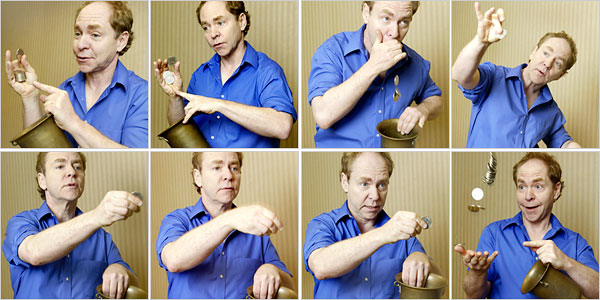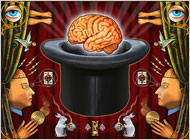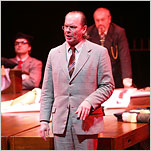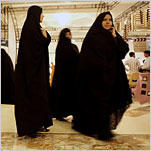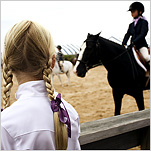The reason he had picked me from the audience, Apollo Robbins insisted, was that I’d seemed so engaged, nodding my head and making eye contact as he and the other magicians explained the tricks of the trade. I believed him when he told me afterward, over dinner at the Venetian, that he hadn’t noticed the name tag identifying me as a science writer. But then everyone believes Apollo — as he expertly removes your wallet and car keys and unbuckles your watch.
It was Sunday night on the Las Vegas Strip, where earlier this summer the Association for the Scientific Study of Consciousness was holding its annual meeting at the Imperial Palace Hotel. The organization’s last gathering had been in the staid environs of Oxford, but Las Vegas — the city of illusions, where the Statue of Liberty stares past Camelot at the Sphinx — turned out to be the perfect locale. After two days of presentations by scientists and philosophers speculating on how the mind construes, and misconstrues, reality, we were hearing from the pros: James (The Amazing) Randi, Johnny Thompson (The Great Tomsoni), Mac King and Teller — magicians who had intuitively mastered some of the lessons being learned in the laboratory about the limits of cognition and attention.
“This wasn’t just a group of world-class performers,” said Susana Martinez-Conde, a scientist at the Barrow Neurological Institute in Phoenix who studies optical illusions and what they say about the brain. “They were hand-picked because of their specific interest in the cognitive principles underlying the magic.”
She and Stephen Macknik, another Barrow researcher, organized the symposium, appropriately called the Magic of Consciousness.
Apollo, with the pull of his eyes and the arc of his hand, swung around my attention like a gooseneck lamp, so that it always pointed in the wrong direction. When he appeared to be reaching for my left pocket he was swiping something from the right. At the end of the act the audience applauded as he handed me my pen, some crumpled receipts and dollar bills, and my digital audio recorder, which had been running all the while. I hadn’t noticed that my watch was gone until he unstrapped it from his own wrist.
“He’s uncanny,” Teller said to me afterward as he rushed off for his nightly show with Penn at the Rio.
A recurring theme in experimental psychology is the narrowness of perception: how very little of the sensory clamor makes its way into awareness. Earlier in the day, before the magic show, a neuroscientist had demonstrated a phenomenon called inattentional blindness with a video made at the Visual Cognition Laboratory at the University of Illinois.
In the video, six men and women — half with white shirts and half with black — are tossing around a couple of basketballs. Viewers are asked to count how many times members of, say, the white team, manage to complete a pass, keeping the ball from the opposition. I dutifully followed the instructions and was surprised when some 15 seconds into the game, laughter began to ripple through the audience. Only when I watched a second time did I see the person in the gorilla suit walking on from stage left. (The video is online at viscog.beckman.uiuc.edu/grafs/demos/15.html.)
Secretive as they are about specifics, the magicians were as eager as the scientists when it came to discussing the cognitive illusions that masquerade as magic: disguising one action as another, implying data that isn’t there, taking advantage of how the brain fills in gaps — making assumptions, as The Amazing Randi put it, and mistaking them for facts.
Sounding more like a professor than a comedian and magician, Teller described how a good conjuror exploits the human compulsion to find patterns, and to impose them when they aren’t really there.
“In real life if you see something done again and again, you study it and you gradually pick up a pattern,” he said as he walked onstage holding a brass bucket in his left hand. “If you do that with a magician, it’s sometimes a big mistake.”
Pulling one coin after another from the air, he dropped them, thunk, thunk, thunk, into the bucket. Just as the audience was beginning to catch on — somehow he was concealing the coins between his fingers — he flashed his empty palm and, thunk, dropped another coin, and then grabbed another from a gentlemen’s white hair. For the climax of the act, Teller deftly removed a spectator’s glasses, tipped them over the bucket and, thunk, thunk, two more coins fell.
As he ran through the trick a second time, annotating each step, we saw how we had been led to mismatch cause and effect, to form one false hypothesis after another. Sometimes the coins were coming from his right hand, and sometimes from his left, hidden beneath the fingers holding the bucket.
He left us with his definition of magic: “The theatrical linking of a cause with an effect that has no basis in physical reality, but that — in our hearts — ought to.”
• • •
In his opening address, Michael Gazzaniga, the president of the consciousness association, had described another form of prestidigitation — a virtual reality experiment in which he had put on a pair of electronic goggles that projected the illusion of a deep hole opening in what he knew to be a solid concrete floor. Jolted by the adrenaline rush, his heart beat faster and his muscles tensed, a reminder that even without goggles the brain cobbles together a world from whatever it can.
“In a sense our reality is virtual,” Dr. Gazzaniga said. “Think about flying in an airplane. You’re up there in an aluminum tube, 30,000 feet up, going 600 miles an hour, and you think everything is all right.”
Dr. Gazzaniga is famous for his work with split-brain patients, whose left and right hemispheres have been disconnected as a last-ditch treatment for severe epilepsy. These are the experiments that have led to the notion, oversimplified in popular culture, that the left brain is predominantly analytical while the right brain is intuitive and laid-back.
The left brain, as Dr. Gazzaniga put it, is the confabulator, constantly concocting stories. But mine was momentarily dumbstruck when, after his talk, I passed through a doorway inside the Venetian Resort Hotel Casino and entered an air-conditioned simulation of the Grand Canal. My eyes were drawn upward to the stunning illusion of a trompe l’oeil sky and what I decided must be ravens flying high overhead. Looking closer, my brain discarded that theory, and I saw that the black curved wings were the edges of discs — giant thumbtacks holding up the sky. Later I was told they were automatic sprinklers, in case the clouds catch fire.
“It’s ‘The Truman Show,’ ” said Robert Van Gulick, a philosopher at Syracuse University, as I joined him at a table overlooking a version of the Piazza San Marco. A sea breeze was wafting through the window, the clouds were glowing in the late afternoon sun (and they were still glowing, around 10:30 p.m., when I headed back toward my hotel). How could we be sure that the world outside the Venetian — outside Las Vegas itself — wasn’t also a simulation? Or that I wasn’t just a brain in a vat in some mad scientist’s laboratory.
Dr. Van Gulick had come to the conference to talk about qualia, the raw, subjective sense we have of colors, sounds, tastes, touches and smells. The crunch of the crostini, the slitheriness of the penne alla vodka — a question preoccupying philosophers is where these personal experiences fit within a purely physical theory of the mind.
Like physicists, philosophers play with such conundrums by engaging in thought experiments. In a recent paper, Michael P. Lynch, a philosopher at the University of Connecticut, entertained the idea of a “phenomenal pickpocket,” an imaginary creature, like Apollo the thief, who distracts your attention while he removes your qualia, turning you into what’s known in the trade as a philosophical zombie. You could catch a ball, hum a tune, stop at a red light — act exactly like a person but without any sense of what it is like to be alive. If zombies are logically possible, some philosophers insist, then conscious beings must be endowed with an ineffable essence that cannot be reduced to biological circuitry.
Dr. Lynch’s fantasy was a ploy to undermine the zombie argument. But if zombies do exist, it is probably in Las Vegas. One evening as I walked across the floor of the Imperial Palace casino — a cacophony of clanging bells and electronic arpeggios — it was easy to imagine that the hominids parked in front of the one-armed bandits were simply extensions of the machines.
“Intermittent conditioning,” suggested Irene Pepperberg, an adjunct associate professor at Brandeis University who studies animal intelligence. If you want to train a laboratory rat to pull a crank to get a food pellet, the reflex will be scratched in deeper if the creature is rewarded with some regularity but not all the time.
Dr. Pepperberg has thrown a wild card into studies of consciousness with her controversial experiments with African gray parrots. With a brain “the size of a walnut,” as she puts it, the birds display what appears to be the cognitive potential of a young child. Her best-known parrot, Alex, can stare at a tray of objects and pick the one that has four corners and is blue. He has also coined his own word for almond — “cork nut.”
With appearances on PBS and a cameo role in a Margaret Atwood novel, “Oryx and Crake,” Alex has entered the popular imagination, while Dr. Pepperberg struggles to find a secure academic position. Critics can’t resist comparing Alex to “Clever Hans,” the famous horse whose arithmetical abilities were exposed as learned responses to his trainer’s subtle cues. Dr. Pepperberg says she controls for that possibility in her experiments and believes her parrots are thinking and expressing themselves with words.
• • •
One evening out on the Strip, I spotted Daniel Dennett, the Tufts University philosopher, hurrying along the sidewalk across from the Mirage, which has its own tropical rain forest and volcano. The marquees were flashing and the air-conditioners roaring — Las Vegas stomping its carbon footprint with jackboots in the Nevada sand. I asked him if he was enjoying the qualia. “You really know how to hurt a guy,” he replied.
For years Dr. Dennett has argued that qualia, in the airy way they have been defined in philosophy, are illusory. In his book “Consciousness Explained,” he posed a thought experiment involving a wine-tasting machine. Pour a sample into the funnel and an array of electronic sensors would analyze the chemical content, refer to a database and finally type out its conclusion: “a flamboyant and velvety Pinot, though lacking in stamina.”
If the hardware and software could be made sophisticated enough, there would be no functional difference, Dr. Dennett suggested, between a human oenophile and the machine. So where inside the circuitry are the ineffable qualia?
Retreating to a bar at the Imperial Palace, we talked about a different mystery he had been pondering: the role words play inside the brain. Learn a bit of wine speak — “ripe black plums with an accent of earthy leather” — and you are suddenly equipped with anchors to pin down your fleeting gustatory impressions. Words, he suggested, are “like sheepdogs herding ideas.”
As he sipped his drink he tried out another metaphor, involving a gold panning technique he had learned about in New Zealand. Lead and gold are similar in density. If you salt the slurry with buck shot and swirl the pan around, the dark pellets will track the elusive flecks of gold.
With a grab bag of devices accumulated over the eons, the brain pulls off the ultimate conjuring act: the subjective sense of I.
“Stage magicians know that a collection of cheap tricks will often suffice to produce ‘magic,’ ” Dr. Dennett has written, “and so does Mother Nature, the ultimate gadgeteer.”
At the end of the magic show where I was fleeced by Apollo, The Amazing Randi called on Dr. Dennett and another volunteer to help with the final act. As Mr. Randi sat on a chair, the two men tightly bound his arms to his thighs with a rope.
“Daniel, would you take off your jacket for me for just a moment?” the conjuror asked. “Now drape it around the front of my hands.”
“A little higher,” Mr. Randi said.
Without missing a beat, he grabbed the collar and pulled it up toward his chin. The audience cheered. Either he had slipped the ropes in a matter of seconds or his hands had been free all along.
“Allow people to make assumptions and they will come away absolutely convinced that assumption was correct and that it represents fact,” Mr. Randi said. “It’s not necessarily so.”




